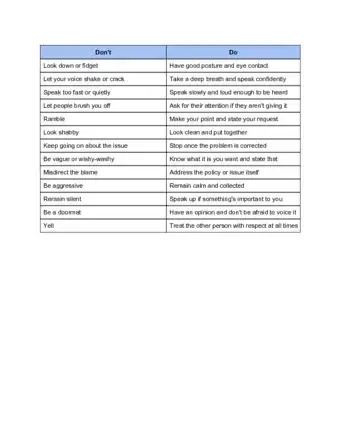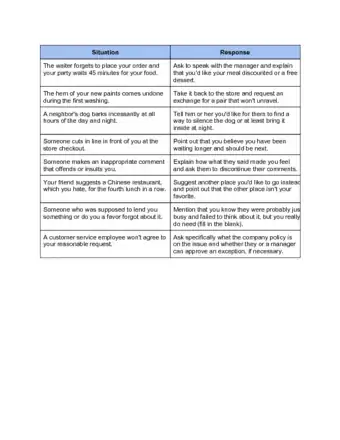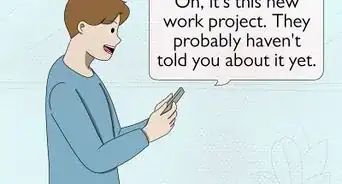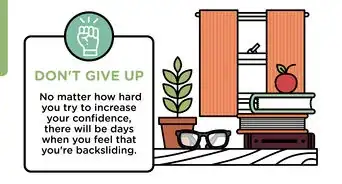This article was co-authored by Maya Diamond, MA. Maya Diamond is a Dating and Relationship Coach in Berkeley, CA. She has 13 years of experience helping singles stuck in frustrating dating patterns find internal security, heal their past, and create healthy, loving, and lasting partnerships. She received her Master's in Somatic Psychology from the California Institute of Integral Studies in 2009.
This article has been viewed 93,317 times.
Being assertive is a constructive way for dealing with difficult people, achieving your goals, and solving a problem. Whether it’s with a co-worker or a friend, communicating confidently and in a straightforward manner can help you get what you need. Being assertive differs from being aggressive as assertiveness involves a constructive and polite attitude. Aggressive behavior involves speaking before you think, insulting people, and not listening to what others need. Be assertive and not aggressive to solve your problems by decompressing from a stressful situation, communicating properly, and understanding others’ point of view.
Steps
Assertiveness Cheat Sheets
Taking a Moment to Reflect
-
1Take a deep breath and smile. By taking a moment to breathe and smile you not only prevent yourself from acting rashly and aggressively, but you release endorphins in your brain.[1]
- Endorphins are released when you smile because your brain has been trained to recognize these muscle movements as positive. Endorphins, along with serotonin keep your mood up and stable.
- Breathing and smiling also relieves stress because it lowers cortisol levels, which is a stress hormone.
-
2Meditate for a few minutes. Meditation doesn’t have to be done by sitting on the floor with your legs crossed. It can be done by going for a walk or finding a quiet place to be alone. You can even use apps on your smartphone to help you time your meditation or walk you through a guided meditation.[2]
- Whether you’re in an office environment or social situation you can always remove yourself from a stressful situation for a few minutes.
- Meditating and clearing your mind for a few minutes will help you formulate a positive plan of action where your can be assertive.
- Acting rashly without thinking can cause you to be aggressive and immature.
- Try sitting down and placing both hands on your belly. Take in a few full breaths. Feel your stomach rise as you breathe in and fall on the out breath.
- Breath through your nose and take long, calm breaths.
Advertisement -
3Remind yourself that your opinion matters. You are within your rights to feel the way you do. You are also capable of confidently and respectfully expressing your point of view. [3]
- Giving yourself a pep talk may sound silly but it can help to boost your confidence and express what you need to in a confident and succinct manner.
- If you try to confront someone without having had time to cool down you are more likely to act aggressively. Aggressive behavior means bullying someone instead of working together to find a solution.
-
4Understand that you can't control the actions and feelings of others. You can only control how you act and feel. Being assertive means focusing on how you handle situations.
- While your goal may be to get someone to change her behavior in a certain manner, you can't force your will on that person. All you can do is communicate what you need and how you feel.
- Aggressive behavior involves trying to assert your will and force a person to change to get what you want. Being assertive involves keeping a cool head and dealing with how you feel and behave.
Behaving Diplomatically
-
1Think carefully before you speak. Even though you’ve taken a few moments to decompress and compose yourself, you may get heated during a conversation. Therefore, remember to always take a moment before speaking.[4]
- You can ensure that you are taking a moment before speaking by listening intently to what the other person is saying.
- Don’t interrupt the other person. Wait until this person has finished speaking before you talk.
- Being assertive means really listening and understanding so you can express what you need.
- Being aggressive means interrupting the other person and speaking over her.
-
2Make an assertive request or statement. Find a moment to talk to the person or persons who you are dealing with and practice direct communication.
- Direct, assertive communication involves understanding where the other person is coming from and expressing your contracting opinion without placing blame.
- Use “I feel” statements. Instead of accusing the other person by saying “you did this” or “you’re behavior is”, express how her actions make you feel.
-
3Use specific declarative statements. Declarative statements help you to paint a clear picture of the situation. And when followed by an “I feel” statement, can be an effective and assertive way to begin resolving an issue.
- Instead of saying something like “You’re always letting me down,” or “You think you’re better than me because you do more work outside of office hours?” Use a statement that's similar to what you might read in a news article. It should be factual and specific.
- "You missed the last three deadlines,” or “You’ve come in ten minutes late three days this week,” are harder to argue with.
-
4Self-reflect and empathize with the other person. Now that you have clearly expressed your feelings on a situation, take a moment to reflect and try to empathize with the other person. Allow them an opportunity to present their viewpoints on the situation, and listen to them with an open mind and heart.
- Use your own experiences to try and find a parallel to the current situation. You’ve probably been in the other person’s shoes before in some sense. How did you react or feel when you were on the other side?
- Try to connect with this other person through your shared emotions or experiences.
- Try to incorporate some humor if you can. Humor is a great way to break the tension and make people feel more comfortable. Humor doesn’t mean of making fun of a person, however. Humor means making light of a situation without blame.
Reaching a Resolution
-
1Validate the other person’s feelings and point of view. Now you can further connect with this person by explaining that how she feels is valid. However, it's her actions which aren’t valid.
- If you’re in a workplace scenario where you are talking to a coworker you can say something like “I understand that the workload and meeting deadlines can be stressful. And you’re right to feel angry or upset, I feel that way sometimes.”
- By connecting with this person, even if it’s hard to, and validating her feelings, you are changing your relationship in a positive way. Instead of being enemies, you are now on the same team.
-
2Establish what changes you need to see. Be clear about what kind of changes you need, and don’t get emotional or irrational. [5]
- You need to set boundaries with the other person. If you outline boundaries for what’s acceptable or what you will put up with, you can begin to work on a resolution.
- If you know that certain things won’t change, focus on things you can change. If you’re in a workplace scenario and this person is never meeting deadlines and always coming in late, focus on one problem at a time. Assertive people will be clear about what is needed but without berating a person. Aggressive behavior involves piling on and being accusatory.
- If having this person meet deadlines is more important than coming in a few minutes late, be clear about it. Say “You haven’t met the last three deadlines, and I need you to meet your deadlines going forward. And if you can’t, then I will have to review your employment status with the company.”
- You’re not circumventing the situation at hand and being vague when you are concrete and specific.
-
3Collaborate on a plan and a singular vision. Now ask this person what the two of you can do to make what you need a reality. Formulate a plan that puts both of you on the same page.
- Being assertive means working together while resolving an issue. Aggressive people will demand a change but not help. And passive-aggressive people will solve a problem without communication at all.
- If you need this person to start meeting deadlines, then together, communicate on how that can be achieved.
- Offer alternative solutions and ask questions. Maybe you need to be better at handing out assignments with more notice. Perhaps the work for this person is too much and she feels that she would perform better in another department or area.
-
4Thank the person and walk away. Once you have reached an agreement, politely thank the person for taking the time to listen to you and work with you.
- Though you may still not be very happy with this person or have more to work on, saying “thank you” shows respect and can make a person feel validated.
- Leave the situation and don’t simmer in it. You’ve asserted yourself and expressed how you feel and what you need. Now it’s time to put the situation behind you.
Expert Q&A
-
QuestionHow can I be nice but assertive?
 Maya Diamond, MAMaya Diamond is a Dating and Relationship Coach in Berkeley, CA. She has 13 years of experience helping singles stuck in frustrating dating patterns find internal security, heal their past, and create healthy, loving, and lasting partnerships. She received her Master's in Somatic Psychology from the California Institute of Integral Studies in 2009.
Maya Diamond, MAMaya Diamond is a Dating and Relationship Coach in Berkeley, CA. She has 13 years of experience helping singles stuck in frustrating dating patterns find internal security, heal their past, and create healthy, loving, and lasting partnerships. She received her Master's in Somatic Psychology from the California Institute of Integral Studies in 2009.
Relationship Coach Come from a place of open vulnerability. If you're open with people and you don't make everything about what you need from them, they'll be more likely to empathize and respond positively.
Come from a place of open vulnerability. If you're open with people and you don't make everything about what you need from them, they'll be more likely to empathize and respond positively. -
QuestionHow would you handle a workplace bully that is denying his inappropriate behavior?
 Paul Chernyak, LPCPaul Chernyak is a Licensed Professional Counselor in Chicago. He graduated from the American School of Professional Psychology in 2011.
Paul Chernyak, LPCPaul Chernyak is a Licensed Professional Counselor in Chicago. He graduated from the American School of Professional Psychology in 2011.
Licensed Professional Counselor Try focusing on just the facts without placing blame on anyone. Facts are easier to work with and validate. Consider getting other co-workers involved as well so that there may be a consensus regarding the inappropriate behavior.
Try focusing on just the facts without placing blame on anyone. Facts are easier to work with and validate. Consider getting other co-workers involved as well so that there may be a consensus regarding the inappropriate behavior.
References
- ↑ http://www.lifehack.org/articles/communication/7-benefits-smiling-and-laughing.html
- ↑ http://www.mindbodygreen.com/0-23040/the-easiest-way-to-de-stress-calm-anxiety-in-5-minutes-a-doctor-explains.html
- ↑ http://psychcentral.com/blog/archives/2014/06/04/5-tips-for-communicating-assertively-without-being-passive-aggressive/
- ↑ Maya Diamond, MA. Master's in Somatic Psychology & Relationship Coach. Expert Interview. 17 January 2019.
- ↑ http://www.artofmanliness.com/2013/02/12/how-to-be-assertive/


-Step-3-Version-2.webp)








































































